TS 23.101
General UMTS Architecture
V18.0.0 (PDF)
2024/03 … p.
V17.0.0
2022/03 16 p.
V16.0.0
2020/06 16 p.
V15.0.0
2018/06 15 p.
V14.0.0
2017/03 16 p.
V13.0.0
2015/12 16 p.
V12.0.0
2014/09 16 p.
V11.0.0
2012/09 16 p.
V10.0.0
2011/03 16 p.
V9.0.0
2009/12 16 p.
V8.0.0
2008/12 16 p.
V7.0.0
2007/06 16 p.
V6.0.0
2005/01 16 p.
V5.0.1
2004/01 16 p.
V4.0.0
2001/04 16 p.
V3.1.0
2000/12 16 p.
GSM Rel-98 v7.0.0
1999/06 18 p.
GSM Rel-97 v6.1.0
1999/02 18 p.
GSM Rel-96 v5.1.0
1996/04 18 p.
GSM Phase-2 v4.0.4
1993/07 16 p.
GSM Phase-1 v3.1.1
1992/02 15 p.
- Rapporteur:
- Mr. Olsson, Magnus
Ericsson LM
Content for TS 23.101 Word version: 18.0.0
0 Introduction
1 Scope
2 References
3 Definitions, symbols and abbreviations
4 General
5 Domains in UMTS
5.1 Domain split
5.2 User equipment Domain
5.3 Infrastructure Domain
6 Functional Communication between UMTS domains
6.1 Transport stratum
6.2 Access Stratum
6.3 Serving Stratum
6.4 Home Stratum
6.5 Application Stratum
$ Change history
0 Introduction p. 4
UMTS will support a wide range of applications with different quality of service profiles. At present many of these applications are not possible to predict. Also the usage of the different applications are difficult to predict i.e. it is not possible to optimise UMTS to only one set of applications. One conclusion of this is that UMTS must be built in such a way that it is flexible and possible to evolve so it will have a long technical lifetime. Therefore a modular approach is recommended when defining the network parts of UMTS. This is in line with the recommendation from GMM. In this context a module represents a part of a UMTS network i.e. one or several physical network nodes that together implements some functionality. The modular approach should also make UMTS possible to implement efficiently in different environments.
1 Scope p. 5
This TS defines the basic physical and functional separation of UMTS. The contents of this specification is limited to those features that are common to all UMTS networks independent of their origin. It identifies and names the reference points and functional groupings appearing at this level.
2 References p. 5
The following documents contain provisions which, through reference in this text, constitute provisions of the present document.
- References are either specific (identified by date of publication, edition number, version number, etc.) or non specific.
- For a specific reference, subsequent revisions do not apply.
- For a non-specific reference, the latest version applies. In the case of a reference to a 3GPP document (including a GSM document), a non-specific reference implicitly refers to the latest version of that document in the same Release as the present document.
3 Definitions, symbols and abbreviations p. 5
3.1 Definitions p. 5
Terms introduced in this document:
Domain:
The highest-level group of physical entities. Reference points are defined between domains.
Stratum:
Grouping of protocols related to one aspect of the services provided by one or several domains.
3.2 Symbols p. 5
For the purposes of the present document, the following symbols apply:
Cu
Reference point between USIM and ME
Iu
Reference point between Access and Serving Network domains
Uu
Reference point between User Equipment and Infrastructure domains, UMTS radio interface
[Yu]
Reference point between Serving and Transit Network domains
[Zu]
Reference point between Serving and Home Network domains
3.3 Abbreviations p. 5
For the purposes of the present document, the following abbreviations apply:
USIM
User Services Identity Module
ME
Mobile Equipment
MT
Mobile Termination
MExE
Mobile Station Application Execution Environment
TE
Terminal Equipment
4 General p. 6
The general UMTS architecture is modelled, at a high level, from both physical and functional viewpoints. The physical aspects are modelled using the domain concept and the functional aspects are modelled using the strata concept.
The two views are introduced separately and then the mapping between the views is discussed.
This specification shows at a basic level physical and functional separations to allow a UMTS network to fit within the context of the IMT-2000 family of networks. It does not attempt to develop aspects of a UMTS network that are highly specific to that implementation.
5 Domains in UMTS p. 6
The following Figure shows the basic domains in UMTS as described in this clause.
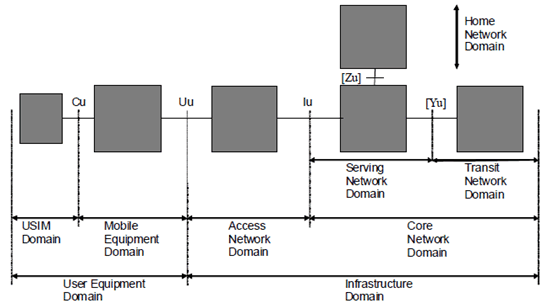
Cu
Reference point between USIM and ME
Iu
Reference point between Access and Serving Network domains
Uu
Reference point between User Equipment and Infrastructure domains, UMTS radio interface
[Yu]
Reference point between Serving and Transit Network domains
[Zu]
Reference point between Serving and Home Network domains
5.1 Domain split p. 7
A basic architectural split is between the user equipment (terminals) and the infrastructure. This results in two domains: the User Equipment Domain and the Infrastructure domain.
User equipment is the equipment used by the user to access UMTS services. User equipment has a radio interface to the infrastructure. The infrastructure consists of the physical nodes which perform the various functions required to terminate the radio interface and to support the telecommunication services requirements of the users. The infrastructure is a shared resource that provides services to all authorised end users within its coverage area.
The reference point between the user equipment domain and the infrastructure domain is termed the "Uu" reference point (UMTS radio interface).
5.2 User equipment Domain p. 7
This domain encompasses a variety of equipment types with different levels of functionality. These equipment types are referred to as user equipment (terminals), and they may also be compatible with one or more existing access (fixed or radio) interfaces e.g. dual mode UMTS-GSM user equipment. The user equipment may include a removable smart card that may be used in different user equipment types. The user equipment is further sub-divided in to the Mobile Equipment Domain (ME) and the User Services Identity Module Domain (USIM).
The reference point between the ME and the USIM is termed the "Cu" reference point.
For the purpose of UMTS Cellular networks the following definition applies:
User Equipment is a device allowing a user access to network services. For the purpose of 3GPP specifications the interface between the UE and the network is the radio interface. A User Equipment can be subdivided into a number of domains, the domains being separated by reference points. Currently defined domains are the USIM and ME Domains. The ME Domain can further be subdivided into several components showing the connectivity between multiple functional groups. These groups can be implemented in one or more hardware devices. An example of such a connectivity is the TE - MT interface. Further, an occurrence of User Equipment is an MS for GSM as defined in TS 24.002.
The figure below shows the Functional Model for the User Equipment, UE.
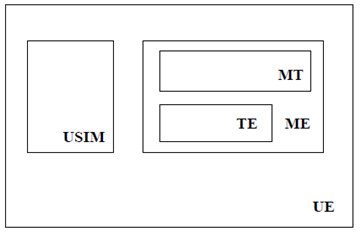
The 07- and 27-series refer to physical instances of this Functional Model. The figure below shows an example of a physical configuration as it could be used in these specifications. The boxes, in this figure, refer to physical elements. The names within brackets are just provided to map the functional blocks from the figure above onto physical elements.
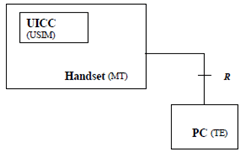
5.2.1 Mobile equipment Domain p. 8
The Mobile Equipment performs radio transmission and contains applications. The mobile equipment may be further sub-divided into several entities, e.g. the one which performs the radio transmission and related functions, Mobile Termination, MT, and the one which contains the end-to-end application or (e.g. laptop connected to a mobile phone), Terminal Equipment. TE. This separation is used in the description of the functional communication in Figure 3 but no reference point is defined in this specification.
5.2.2 USIM Domain p. 8
The USIM contains data and procedures which unambiguously and securely identify itself. These functions are typically embedded in a stand alone smart card. This device is associated to a given user, and as such allows to identify this user regardless of the ME he uses.
5.3 Infrastructure Domain p. 8
The Infrastructure domain is further split into the Access Network Domain, which is characterised by being in direct contact with the User Equipment and the Core Network Domain. This split is intended to simplify/assist the process of de-coupling access related functionality from non-access related functionality and is in line with the modular principle adopted for the UMTS.
The Access Network Domain comprises roughly the functions specific to the access technique, while the functions in the Core network domain may potentially be used with information flows using any access technique. This split allows for different approaches for the Core Network Domain, each approach specifying distinct types of Core Networks connectable to the Access Network Domain, as well as different access techniques, each type of Access Network connectable to the Core Network Domain.
The reference point between the access network domain and the core network domain is termed the "Iu" reference point.
5.3.1 Access Network Domain p. 8
The Access Network Domain consists of the physical entities which manage the resources of the access network and provides the user with a mechanism to access the core network domain.
Additional reference points within the access domain may be identified in other specifications.
5.3.2 Core Network Domain p. 9
The Core Network Domain consists of the physical entities which provide support for the network features and telecommunication services. The support provided includes functionality such as the management of user location information, control of network features and services, the transfer (switching and transmission) mechanisms for signalling and for user generated information.
[Note: Much more could/should be written about the reference points between the core network and other networks].
The core network domain is sub-divided into the Serving Network Domain, the Home Network Domain and the Transit Network Domain.
The reference point between the serving network domain and the home network domain is termed the [Zu] reference point.
The reference point between the serving network domain and the transit network domain is termed the [Yu] reference point.
Additional sub-divisions and reference points within the core network domain may be identified in other specifications.
5.3.2.1 Serving Network Domain p. 9
The serving network domain is the part of the core network domain to which the access network domain that provides the user's access is connected. It represents the core network functions that are local to the user's access point and thus their location changes when the user moves. The serving network domain is responsible for routing calls and transport user data/information from source to destination. It has the ability to interact with the home domain to cater for user specific data/services and with the transit domain for non user specific data/services purposes.
5.3.2.2 Home Network Domain p. 9
The home network domain represents the core network functions that are conducted at a permanent location regardless of the location of the user's access point.
The USIM is related by subscription to the home network domain. The home network domain therefore contains at least permanently user specific data and is responsible for management of subscription information. It may also handle home specific services, potentially not offered by the serving network domain.
5.3.2.3 Transit Network Domain p. 9
The transit network domain is the core network part located on the communication path between the serving network domain and the remote party. If, for a given call, the remote party is located inside the same network as the originating UE, then no particular instance of the transit domain is activated.
6 Functional Communication between UMTS domains p. 9
The following strata have been identified within UMTS:
- Application stratum;
- Home stratum;
- Serving stratum and
- Transport stratum
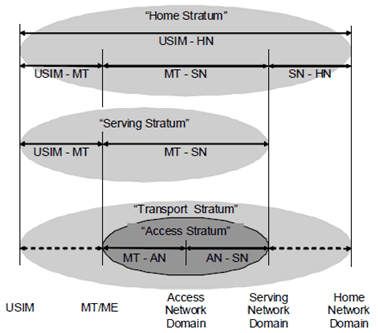
Figure 2: Functional flows between the USIM, MT/ME, Access Network, Serving Network and Home Network domains
(⇒ copy of original 3GPP image)
(⇒ copy of original 3GPP image)
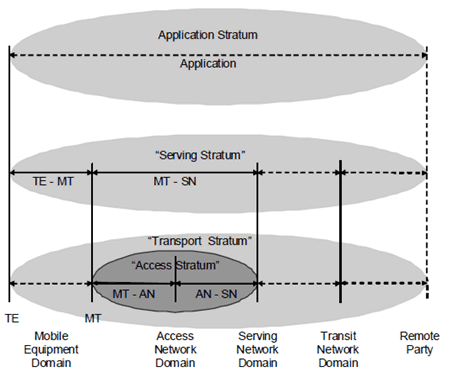
Figure 3: Functional flow between TE, MT, Access Network, Serving Network, Transit Network domains and the Remote Party
(⇒ copy of original 3GPP image)
(⇒ copy of original 3GPP image)
The "Remote Party" represents the remote end entity (user or machine) and is included in the Figure to show the end-to-end character of the communication, the specification of the remote party is outside the scope of the UMTS specifications.
6.1 Transport stratum p. 11
This stratum supports the transport of user data and network control signalling from other strata through UMTS. The transport stratum includes consideration of the physical transmission format used for transmission and also:
- mechanisms for error correction and recovery;
- mechanisms to encrypt data over the radio interface and in the infrastructure part if required;
- mechanisms for adaptation of data to use the supported physical format (if required); and
- mechanisms to "transcode" data to make efficient use of, e.g., the radio interface (if required).
6.2 Access Stratum p. 12
This is the functional groupings consisting of the parts in the infrastructure and in the user equipment and the protocols between these parts being specific to the access technique (i.e. the way the specific physical media between the User Equipment and the Infrastructure is used to carry information). The access stratum provides services related to the transmission of data over the radio interface and the management of the radio interface to the other parts of UMTS.
The access stratum includes the following protocols:
- Mobile Termination - Access Network This protocol supports transfer of detailed radio-related information to co-ordinate the use of radio resources between the MT and the access network.
- Access Network - Serving Network This protocol supports the access from the serving network to the resources provided by the access network. It is independent of the specific radio structure of the access network.
6.3 Serving Stratum p. 12
This stratum consists of protocols and functions to route and transmit data/information, user or network generated, from source to destination. The source and destination may be within the same or different networks. Functions related to telecommunication services and are located in this stratum.
The serving stratum includes the following protocols:
- USIM - Mobile Termination This protocol supports access to subscriber-specific information for support of functions in the user equipment domain.
- Mobile Termination - Serving Network This protocol supports access from the MT to the services provided by the serving network domain.
- Terminal Equipment- Mobile Termination This protocol support exchange of control information between the TE and the MT.
6.4 Home Stratum p. 12
This stratum contains the protocols and functions related to the handling and storage of subscription data and possibly home network specific services. It also includes functions to allow domains other than the home network domain to act on behalf of the home network. Functions related to subscription data management, customer care, including billing and charging, mobility management and authentication are located in this stratum.
The home stratum includes the following protocols:
- USIM - Home Network This protocol supports co-ordination of subscriber-specific information between the USIM and the home network.
- USIM - MT This protocol provides the MT with access to user specific data and resources necessary to perform actions on behalf of the home network.
- MT - Serving Network This protocol supports user specific data exchanges between the MT and the Serving Network.
- Serving Network - Home Network This protocol provides the serving network with access to home network data and resources necessary to perform its actions on behalf of the home network, e.g., to support the users communications, services and features (including VHE).
6.5 Application Stratum p. 13
This stratum represents the application process itself, provided to the end-user. It includes end-to-end protocols and functions which make use of services provided by the home, serving and transport strata and infrastructure to support services and/or value added services.
The functions and protocols within the application stratum may adhere to GSM/UMTS standards such as MExE or may be outside the scope of the UMTS standards. However, the definition of the services provided by the other strata, and the interfaces to them, is within the scope of the standards
End-to-end functions are applications which are consumed by users at the edge of/outside the overall network. The applications may be accessed by authenticated users who are authorised to access such applications. The users may access the applications by using any of the variety of available user equipment.